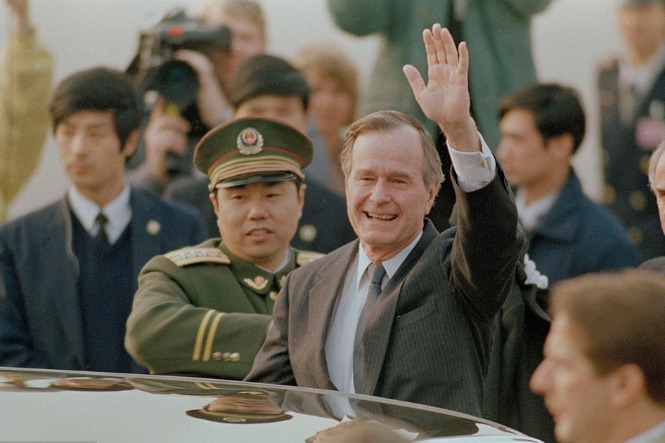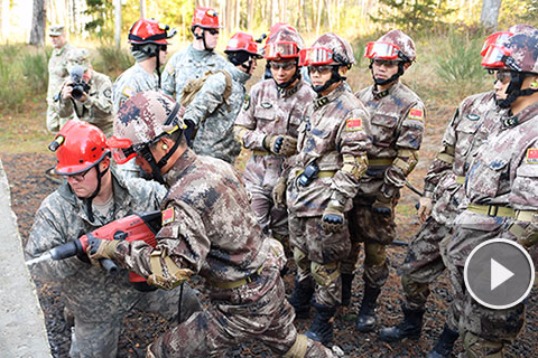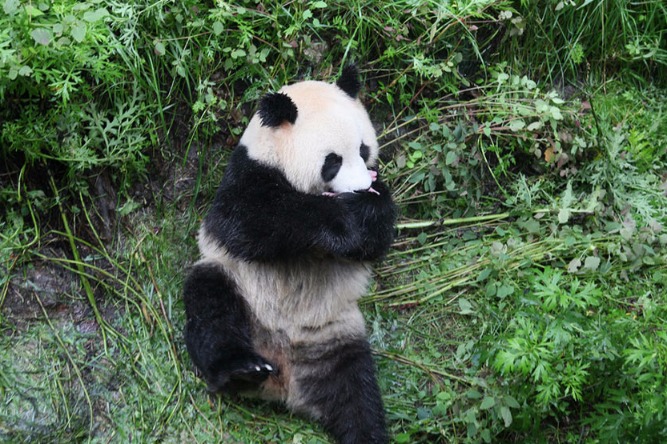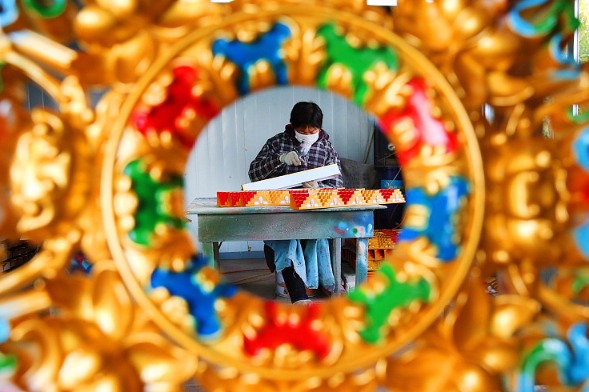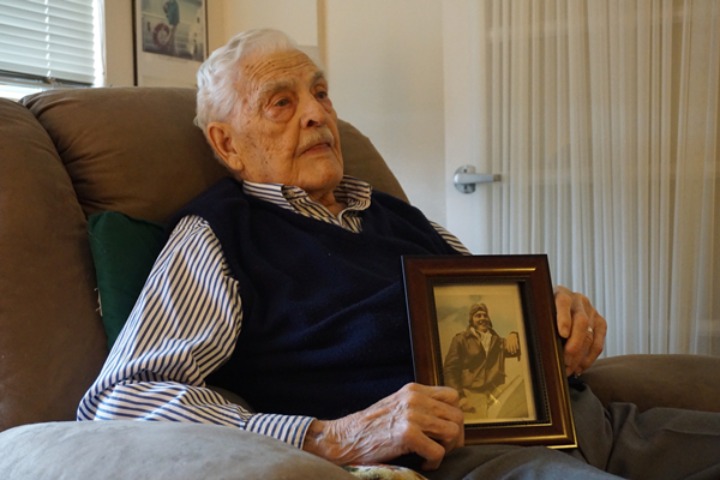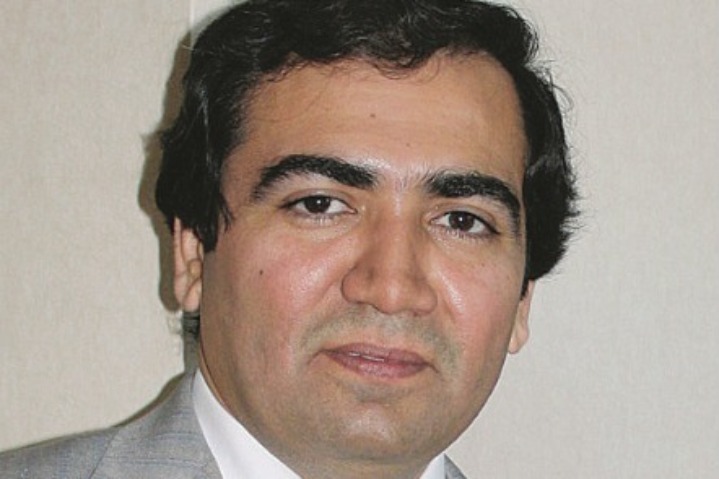Cameras and carbines capture life during wartime
During World War II, a team of US army photographers spent two years recording the everyday lives and struggles of people living in and around the China-Burma-India Theater, which saw some of the fiercest action of the war in the Pacific. Zhao Xu reports.
Editor's Note: This is the seventh in a series of special reports about the experiences of foreigners who either lived or served in China between 1937 and 1945.
US army veteran Sydney Greenberg slept with "a light in the hallway and a flashlight by his bed all the time", according to his son, Philip.
The old soldier died in January 2012, 67 years after returning from the China-Burma-India Theater, one of the toughest, but least-reported, battlegrounds of World War II, where he roamed the countryside carrying a carbine in one hand and a camera in the other.
"My father was a member of the US army's 164th Signal Photo Company, assigned to the CBI to record the war in images," Philip Greenberg wrote in an e-mail exchange with China Daily. "There was one night in China when the Japanese snuck into the camp while the soldiers slept - my dad and his captain were near the center of the camp in hammocks with Chinese soldiers all around them. When dad woke up, he found that most of the men around him had had their throats cut. It seems the Japanese had worked their way from the fringes of the camp towards the center, killing off the soldiers closest to them. From that moment until the end of his life, dad was never able to shake off his fear of the dark," he said.
Very little of that darkness haunts the thousands of photos Sydney Greenberg took during a two-year stay in China's southwestern border region. Instead, his portfolio is tinged with warmth, and includes idyllic landscapes where the presence of war is only suggested by a rear view of a soldier. In one photo, a cameraman films Chinese children with a motion-picture camera, a device that had evidently captured the boys' imagination.
"Most of my dad's images show how the Chinese had tried to stabilize life a little bit within a war zone, and how they dealt with everyday life as it appeared in front of them. He photographed the people around him who were part of his life and part of the war," Philip Greenberg said.
'Soldiers and artists'
Sydney Greenberg arrived in Kunming, the capital of Yunnan province, at the end of 1943 and was "welcomed by another air raid", as he noted in his diary. The 23-year-old photographer had just spent more than a month at sea, accompanied by his comrades in the 164th Signal Photo Company. When the vessel reached India, the 250-strong company - officers, other ranks, photographers and darkroom technicians - was divided into two equal groups. One group stayed in India, while the other, including Greenberg, headed to China.
Referring to the men of the 164th Signal as "soldiers and artists", Niu Zi, a documentary filmmaker and amateur historian, said the company's photos bear witness to the neglected history of the war in the CBI.
"During the war, the US army sent camera companies to all their overseas battlefields. In that sense, the 164th Photo Company was not special. However, bearing in mind that cameras were very much a rarity in that part of China in the 1940s, the black-and-white photos and movie footage constitute not just footnotes to history, but history itself," he said.
The bulk of the company's images are housed at the National Archives and Records Administration in Washington, and in 2010 Niu and some friends spent two months at the archives searching, photocopying and recording everything they could find related to China and the CBI during WWII.
Yan Huan, whose grandfather, Pan Yukun, fought in the CBI as a general in the Chinese Nationalist Army, accompanied Niu to Washington. "There were an estimated 23,000 pictures in total. Almost all of the ones labeled 'Signal Corps' or 'US Army Photo' can be attributed to the click of a camera belonging to the 164th Signal Photo Company," he said.
The photographers were truly "embedded", long before the word became popular in modern warfare. "My dad used to say: 'We lived in the same conditions as the Chinese. We ate, drank, slept and dressed as if we were the Chinese. When they didn't bathe or wash, we didn't either, so eventually we smelled the same'," Philip Greenberg said.
Most of the time, the US soldiers dressed like Chinese infantrymen, right down to the rope sandals they wore on their feet - and with good reason.
"The Chinese told them that they shouldn't keep wearing their US-issued uniforms - the Japanese actively sought out the highest-ranking US personnel in the command and shot them," Philip Greenberg said. "It wasn't long before my dad's captain, who wore a US Army helmet, was killed by a Japanese sniper."
Although the US troops generally acclimatized well, there were some things they couldn't endure. Adding a snake or rodent to the menu of endless bowls of rice may have filled Sydney Greenberg's stomach, but drinking untreated ditchwater left him with malaria and dysentery, which reduced his body weight by half.
The hardships didn't stop him from opening his mind - and heart - to the Chinese people, though. Having been taught what he called "Chinese decorum" (appropriate behavior) on the voyage, the soldier/photographer discovered a "secret weapon" - cigarettes.
"My mom, who worked in a supply outfit at home, would send dad packs of cigarettes," Philip Greenberg said. After he handed out the cigarettes to the locals, the elder Greenberg was rewarded with a new level of access and intimacy, and his subjects - such as a happy mother and her beaming infant daughter - appear totally unguarded and at ease.
In one of Greenberg's best-known photos, a gun-toting Chinese soldier is depicted from behind as he stands on top of a tank in the monsoon season, watching as a US air force plane appears out of the clouds, dropping food for the Allies. While the leaden sky and heavy, low-hanging clouds conjure up an apocalyptic atmosphere, the towering image of the soldier appears as a beacon of hope and a powerful symbol of resistance.
Although, the heavy equipment and safety concerns - the photographers were usually guarded by Chinese soldiers - often prevented the team from shooting or filming on the front line, the photo company also had other, less deadly enemies.
"Hedge's 35mm Kodak has a case of termites today," Sydney Greenberg wrote in his diary, with reference to Arthur Hedge, a fellow cameraman. "Seems he hung his camera on a tree and a mother termite - pregnant, of course - got into the opening above the lens. This afternoon, while taking pictures, he discovered a million termites running all over the box; so we spent the latter part of the afternoon smoking them out."
On the same day, he wrote: "At night, I put the camera in a gas cape and put the whole package in the musette bag, but in the morning I have a nice batch of green mold all over the camera and even inside the lens board."
The photos were sent to primitive laboratories, mud buildings where chemicals were weighed on aged scales borrowed from drugstores, for overnight developing and printing.
When the soldiers were not out snapping their shutters right and left, they "sat in dugout trenches and watched the bursts of hand grenades", as Sydney Greenberg described it, recording what they saw in their mind's eye. "It's almost like a motion picture. Flares light up the sky; red, blue, and green, then a white one," he wrote in his diary. "The major tells us that the first three Jap strong-points are ours."
On Sept 9, 1945, the Japanese army officially surrendered to the Chinese army in Nanjing, then known as Nanking.
The war was over, and Sydney Greenberg was on hand to capture the jubilation on film. "While in Nanking, my dad was given two options: he could fly to Shanghai and from there go back to the States by ship; or, he could go to Kunming, the city of his arrival, and then go to India, where he would board a ship," Philip Greenberg said. "Dad chose to honor the memory of his arrival."
Post-war 'pengyou'
After the war, Sydney Greenberg continued to take photos. He also served his hometown as justice of the peace for more than 40 years, a role that enabled him to "marry countless couples in his inimitable style of pomp, circumstance and levity", according to his obituary in the local newspaper.
He also gave regular lectures about his days in China, but despite his love of the country, he was reluctant to return. "He wanted the memories he had collected to remain undisturbed," Philip Greenberg said.
In 2011, the elder Greenberg was delighted to learn that a team of history enthusiasts from China, including Niu and Yan, was mounting an exhibition in Chongqing to showcase the work of the 164th Signal Photo Company. The 92-year-old veteran was invited to visit the exhibition, but was unable to travel because he was recovering after a car accident. Instead, he recorded a video to be shown at the opening of the exhibition: "A new and fascinating world was opened to me. You people took me in as a 'pengyou'", he told the audience, using the Chinese expression for "friend".
Sometime around 1944, Greenberg's fluency in Chinese brought him into contact with Chiang Kai-shek, the leader of the Nationalist government. "There's this great image of Chiang turning away from a gathering of reporters to smile at dad, who said 'Can I take your photo, sir Chinese," Philip Greenberg said.
Having been assigned to photograph Chiang during his flying inspection trips, the young soldier also taught the Nationalist leader how to use his 35mm Leica camera.
Earlier this year, while going through the photos he had copied at the National Archive in Washington, Yan stumbled over a "Greenberg" that had previously eluded him. "If you had been with me at the National Archive in 2010, you'd know how frequently we came across pictures with 'S.L. Greenberg' written on the back. But this picture is of, rather than by, Mr. Greenberg, so it's very precious," said Yan, who had corresponded with the old soldier by e-mail and wrote the family a letter of condolence when the veteran died. In the photo, Greenberg is shown sitting in an army jeep with five Chinese youths.
"Horror and amazement; a camera for a few years and an adventure of a lifetime - that's what China meant to dad," said Philip Greenberg, who, inspired by his father's example, became a photojournalist and undertook more than 2,300 assignments for major US newspapers and magazines. "I followed dad's work, and I became part of his legacy."
Reflecting on his father's experiences in wartime China, he said: "They (the Chinese) showed him kindness and gave him their time; he honors them daily in his photographs."
Zhang Yuchen contributed to this story.
Contact the writer at zhaoxu@chinadaily.com.cn

| Sydney Greenberg, a veteran of the US army's 164th Signal Photo Company, with some of the photos he took in China during World War II. Photos Provided to China Daily |
| Sydney Greenberg with Chinese youths in Yunnan province in 1944. |
| A soldier-cameraman shoots footage of local children. |
| Camera and carbine: the dual weapons of the Photo Company. |
(China Daily USA 07/30/2015 page5)











